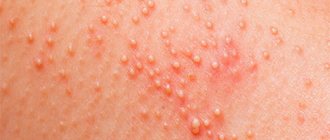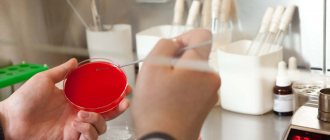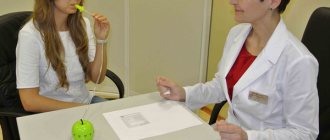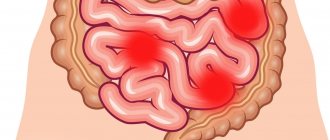Biochemical analysis of stool for dysbacteriosis is a method of studying intestinal microflora, intended to establish the level of biochemical indicators.
Biochemical analysis informs about the predominance of certain types of bacteria in the intestines (Escherichia coli, bifidobacteria, lactobacilli, fungi, etc.).
It is carried out by establishing the spectrum of fatty acids, which are a product of the vital activity of intestinal bacteria.
As is known, the human intestine is practically sterile only at the moment of birth. Already in the first hours of a baby’s life, this organ is populated by entire colonies of various bacteria. Most intestinal bacteria perform useful work: they help digest food and neutralize harmful toxins. But there are also representatives of bacterial microflora that can cause health problems - from bloating to appendicitis.
As a rule, the normal number of beneficial bacteria in the intestines of an adult is about 85% of their total number, and pathogenic microorganisms - 15%. If this balance is disturbed, a condition such as dysbiosis may occur.
Symptoms of intestinal dysbiosis are quite varied: they include flatulence, diarrhea, and many other disorders of the digestive tract. Dysbacteriosis, in turn, can itself be a symptom of a number of quite serious diseases, so doctors often prescribe a stool test for dysbiosis.
Indications for use
A biochemical analysis of stool for dysbacteriosis can be prescribed in the following cases:
unstable stool (constipation, diarrhea) for a long time; pain in the abdomen; constant flatulence; intolerance to a number of food products; skin rashes; food allergies; after prolonged (more than seven days) therapy with antibiotics, anti-inflammatory drugs or hormones; the presence of other gastroenterological diseases (cholecystitis, pancreatitis, intestinal diseases).
Dysbacteriosis is not just an unpleasant condition, but an indicator of the presence of more serious health problems. Therefore, if a doctor prescribes a biochemical stool test to identify this disorder, you should definitely undergo this examination.
How to prepare?
To ensure that the analysis results are as objective as possible, you should pay attention to the following requirements:
three to four days before the test, stop taking any laxatives; the analysis is prescribed no earlier than 10-14 days after discontinuation of antibiotics (if they were previously prescribed); bowel movements should occur naturally, and not with the help of an enema; to collect stool, you should first purchase a special container with a tight lid from a pharmacy or medical facility; Drops of urine or discharge should not get into the stool (in women); the volume of material required for analysis is at least 10 ml; It is advisable to take material for research from different parts of the stool using special spoons supplied with the container. If mucus or blood that has entered it from the intestines is visible in the stool, they are also collected along with the bulk of the material; the sample must be delivered to the laboratory no later than three hours after its collection. If the material cannot be delivered within the specified time frame, then the sample can be frozen in a freezer and then delivered the next day.
Standard analysis values
When processing the results of biochemical analysis, the absolute content of acids (unit of measurement - mg/g) and their relative content (unit of measurement - unit) are determined.
Acceptable values of the studied indicators are:
| Indicators (monocarboxylic acids) | Absolute content, mg/g | Relative content, units. | ||
| normative meaning | valid values | normative meaning | valid values | |
| Acetic (C2) | 5,88 | 5,35-6,41 | 0,634 | 0,612-0,656 |
| Propionic (C3) | 1,79 | 1,63-1,95 | 0,189 | 0,18-0,198 |
| Oil (C4) | 1,75 | 1,6-1,90 | 0,176 | 0,167-0,185 |
| other indicators: | ||||
| IsoСn/Cn | 0.43 units | 0,29-0,57 | 0.45 units | 0,3-0,6 |
| Total content (C2+…C6) | 10.51 mg/g | 8,01-13,01 | 10.5 mg/g | 9,0-12,01 |
| Anaerobic index (C2-C4) | -0.576 units | -0.686 to -0.466 | -0.578 units | -0,69/-0,466 |
The conclusion form usually contains a description of the intestinal microbiocenosis, detected pathologies of the digestive system, and a list of recommended therapeutic measures to eliminate the detected disorders.
What can you find?
Using biochemical analysis of stool, the following diseases and disorders can be diagnosed:
irritable bowel syndrome; nonspecific ulcerative colitis; intestinal tumors; disorders of the liver (hepatitis, cirrhosis); pancreatic insufficiency; other pathologies of the stomach and intestines.
You should be aware that conducting a biochemical analysis is not advisable if infectious diseases of the digestive tract are suspected. In these cases, other types of research are carried out aimed at identifying the source of infection.
But in a situation where it is necessary to find the cause of dysbiosis, it is better to give preference to biochemical analysis, because this method is the most accurate and fastest. It should also be taken into account that only a doctor should decipher the results of the study, since a non-specialist is unlikely to be able to understand the reasons for deviations from the norm of certain parameters. Therefore, if the doctor recommends the above method, you should not refuse the offer, because with its help you can obtain important results for diagnosing the disease.
Do you still think that healing your stomach and intestines is difficult?
Judging by the fact that you are now reading these lines, victory in the fight against diseases of the gastrointestinal tract is not yet on your side...
Have you already thought about surgery? This is understandable, because the stomach is a very important organ, and its proper functioning is the key to health and well-being. Frequent abdominal pain, heartburn, bloating, belching, nausea, bowel dysfunction... All these symptoms are familiar to you firsthand.
But perhaps it would be more correct to treat not the effect, but the cause? Here is the story of Galina Savina, about how she got rid of all these unpleasant symptoms... Read the article >>>
Dysbacteriosis is the result of pathological processes occurring in the body of a sick person. The disease not only does not have pronounced symptoms, but also does not have a special clinical picture. That is why identifying dysbiosis is not as simple as it might seem at first glance. A patient who has developed this disease to a greater or lesser extent experiences slight discomfort in the gastrointestinal tract, barely noticeable nausea and (in rare cases) an increase in temperature. Such symptoms can be associated with a disease of any organ. In some cases, dysbacteriosis proceeds completely unnoticed, and the only way to determine the presence or absence of the disease is to conduct competent and professional laboratory diagnostics.
Analysis of stool for dysbacteriosis can reveal the state of imbalance of the patient’s microflora even in the early stages of its occurrence. Today, in laboratory conditions, depending on the clinical picture and condition of the patient, medical staff can conduct two methods of stool analysis: bacteriological and biochemical. The most modern and popular, of course, is the biochemical method. Bacteriological analysis is perfect for primary or basic diagnosis. Having a number of significant drawbacks, this method of identifying dysbacteriosis is not only quite complex, but also inaccurate.
Methods
There are three ways to test for dysbacteriosis:
- Coprogram;
- Bacteriological;
- Biochemical.
Will the coprogram show dysbiosis?
A coprogram is a microbiological analysis of intestinal microflora, used after long-term use of antibiotics not associated with diseases of the gastrointestinal tract. And it identifies pathology by the appearance of feces and determines the presence of:
- Fragments of undigested food;
- Starch;
- Helminths and their eggs;
- Fat;
- Blood and mucus.
Bacterioscopic examination is the first stage of microbiological analysis. The thick part of stool consists of 30% microorganisms. In this case, the intestinal flora is not microscopically distinguished using colored preparations. Bacterioscopically it is possible to isolate iodophilic flora and tuberculosis bacillus.
Bacteriological research - how much and how it is done
If the coprogram shows an imbalance, then the doctor prescribes a more accurate study. A bacteriological culture of feces is performed in a nutrient medium. In some cases, an analysis is performed for bacteriosis of the oral cavity. A scraping is taken from the oral mucosa, then a tank is performed. sowing. After 5-7 days, when the bacteria multiply, they are recounted. Based on the results of bacteriological examination of feces, the specialist gives an opinion. If organs other than the intestines are involved in the pathological process, a detailed analysis of blood and urine is performed.
Rules for collecting stool for dysbacteriosis
In order for the outcome of the study to be effective and as accurate as possible, it is necessary to strictly adhere to the established rules for collecting stool for dysbacteriosis. First of all, you need to know what tests you need to take, what they are for, what the duration and cost of this procedure are. The timing of obtaining the finished result also plays an important role.
It is also worth considering that specialists need freshly excreted feces to collect tests. If all this time the patient is using any laxatives or any other medications, they must be discontinued two to four days before the procedure. The same applies to Vaseline oil, as well as the regular administration of any rectal suppositories. In addition, stool obtained after an enema or taking any medications is unsuitable for further research.
When collecting stool, it is necessary to use the natural defecation method. Before this, the patient should urinate to avoid urine feces getting into a special vessel, which must be pre-treated with an antibacterial agent, rinsed with water, and then rinsed with boiling water. Next, the material is placed in a closed container. The space occupied by feces should not exceed one third of its total volume. Please note that within two to three hours the material must be delivered to the analysis collection point. During this time, it is advisable to store it in a cool room, using either a special refrigerated container or a box of ice. Freezing of the product, as well as its long-term (more than three hours) storage is not allowed. Close the stool container tightly and securely and do not store it in any other environment. On the top of the container you must write the patient’s name, date of birth, and the time of collection of stool.
Decoding stool analysis
| Analysis for dysbacteriosis. Normal indicators | |
| Microflora | Normal indicators |
| Pathogenic enterobacteria | None |
| Escherichia coli with normal enzymatic activity (Esherechia) | 300-400 million/year |
| Escherichia coli with reduced enzymatic activity | To 10% |
| Lactose-negative enterobacteriaceae | Up to 5% (103-106 million/year) |
| Hemolyzing Escherichia coli | Absent |
| Coccal forms in the total amount of microbes | Up to 25% (107 million/year) |
After submitting the material for examination, specialists carry out a special procedure called stool culture. It is carried out in a favorable nutrient environment in which the level of development and reproduction of bacteria reaches its maximum. Most often, sowing lasts 3-5 days, after which doctors study under a microscope the number of microorganisms found in one gram of feces. This indicator is measured in CFU/g and is indicated in the finished table in the form of the following colony-forming units:
clostridium; streptococcus; hemolytic and non-hemolytic staphylococci; Escherichia; peptococcus and bacteroides; bifidobacteria; lactobacilli
Taking into account the above indicators, you can easily and quickly assess the state of your own microflora, based on the numbers indicated in the laboratory certificate.
Main groups of intestinal bacteria
Special attention should be paid to the classification of bacteria in the patient’s body. So, all bacteria are divided into the following groups:
Normal - microorganisms that take a very active part in all vital processes of the intestinal tract. Represented by bifidobacteria, lactobacilli and Escherichia. Opportunistic pathogens are bacteria that, under certain conditions, can contribute to the development and aggravation of dysbacteriosis. They are divided into enterococci, staphylococci and candida. Pathogenic – microorganisms accompanied by severe infectious and intestinal diseases. They are represented by two types of bacteria: shingella and salmonella.
How to quickly recover from an infection?
Restoration and preservation of a sufficient amount of beneficial normal intestinal flora - lacto- and bifidobacteria, helps protect the intestinal mucosa from the penetration of pathogenic bacteria and their toxins into the blood and lymph, removes toxins, creates an environment in which pathogenic microorganisms cannot continue their vital activity and are eliminated from the human body . It is important that waste products of beneficial bacteria help the immune system remain active in the fight against harmful bacteria.
The synbiotic biocomplex Normoflorins - containing live active lacto- and bifidobacteria and their metabolites with anti-inflammatory, antiseptic, immunogenic and nutritional effects on mucous membranes has proven itself over many years as an active assistant and fighter against pathogenic bacteria for children and adults, pregnant women and patients with various diseases . Quite quickly, when using Normoflorins, intoxication is relieved and intestinal function and general well-being are restored.
It is recommended: as early as possible, start taking Normoflorin in age-specific dosages - L - 10-15 minutes before meals in the morning (+ lunch for constipation), D - lunch or evening 20 minutes before meals, B - at night or in a microenema. Duration of use is 3-4 weeks, until intestinal function is completely restored and overall well-being improves. It is advisable to take sorbents on an empty stomach for 10-14 days - to remove toxins - zosterin or pecto, they reduce putrefaction, fermentation processes, increased gas formation, and improve intestinal function.
It is important to consolidate the effect of microflora restoration, improve the functioning of the pancreas, liver, intestines, and immunity - for this it is good to use functional nutrition for a month - Harmony of Life. It also contains live beneficial lacto- and bifidobacteria, their metabolites and pectin. Tasty, healthy and effective!
The form for each test for dysbacteriosis contains microflora indicators
Pathogenic enterobacteria.
Usually this indicator comes first on the analysis form. This group of microorganisms includes bacteria that cause acute intestinal infections (salmonella, shigella - the causative agents of dysentery, the causative agents of typhoid fever). The detection of these microorganisms is no longer an indicator of dysbiosis, but an indicator of a serious infectious intestinal disease.
Bifidobacteria.
These are the main representatives of normal intestinal microflora, the number of which in the intestine should be 95 - 99%. Bifidobacteria perform the important work of breaking down, digesting and absorbing various food components, such as carbohydrates; they themselves synthesize vitamins and also promote their absorption from food; with the participation of bifidobacteria, iron, calcium and other important microelements are absorbed in the intestines; bifidobacteria stimulate the motility of the intestinal wall and promote normal bowel movements; bifidobacteria neutralize various toxic substances that enter the intestines from the outside or formed as a result of the activity of putrefactive microorganisms. The analysis form indicates the titer of bifidobacteria, which should be no less than 107 - 109. A significant decrease in the number of bifidobacteria is always a sign of severe dysbacteriosis.
Lactobacilli (lactobacillus, lactic acid microbes, lactic acid streptococci).
The second largest representative (5% of the total intestinal microorganisms) and the most important representative of the normal flora. Lactobacilli, or lactic acid microbes, as their name indicates, produce lactic acid, an essential component for normal intestinal function. Lactobacilli provide antiallergic protection, promote normal bowel movements, and produce highly active lactase, an enzyme that breaks down milk sugar (lactose). In the analysis, their number should be no less than 106 - 107. Lactobacilli deficiency can lead to the development of allergic diseases, constipation, and lactase deficiency.
Escherichia coli with normal enzymatic activity (Escherichia).
It should be noted that the bacteria of normal intestinal flora live by attaching to the intestinal wall and forming a film covering the intestines from the inside. All absorption in the intestines occurs through this film. Bacteria of normal intestinal microflora collectively provide 50–80% of total digestion, and also perform protective (including antiallergic) functions, neutralize the effects of foreign and putrefactive bacteria, promote bowel movements, and provide adaptation to nutrition and external influences.
Escherichia coli with reduced enzymatic activity.
This is an inferior E. coli, which does not pose any harm, but does not perform its beneficial functions. The presence of this indicator in the analysis is a sign of incipient dysbiosis, and just as a decrease in the total amount of E. coli can be an indirect sign of the presence of worms or protozoa in the intestines.
Some analyzes describe bacteroides, the role of which is unclear, but it is known that these are not harmful bacteria; usually their quantity is of no practical importance.
All other microflora indicators are opportunistic flora. The very term “opportunistic” indicates the essence of these microbes. They become pathogenic (disrupting normal intestinal functions) under certain conditions: an increase in their absolute number or percentage of the normal flora, with the ineffectiveness of protective mechanisms or a decrease in the function of the immune system. Opportunistic pathogenic flora are lactose-negative enterobacteria (Klebsiella, Proteus, Citrobacter, Enterobacter, Hafnia, Serration), hemolyzing Escherichia coli and various cocci (enterococci, epidermal or saprophytic staphylococci, Staphylococcus aureus). In addition, clostridia, which are not sown in all laboratories, are opportunistic pathogens. Opportunistic pathogenic flora, competing with beneficial bacteria, penetrates into the microbial film of the intestine, colonizes the intestinal wall and causes disruption of the entire gastrointestinal tract. Intestinal dysbiosis with an increased content of opportunistic flora can be accompanied by allergic skin reactions, stool disorders (constipation, diarrhea, greens and mucus in the stool), abdominal pain, bloating, regurgitation, vomiting. In this case, the body temperature usually does not increase.
Coccal forms in the total amount of microbes.
The most harmless representatives of opportunistic flora are enterococci. They are most often found in the intestines of healthy people, their amount up to 25% does not pose a threat to health. If the number exceeds 25% (more than 107), this is most often due to a decrease in normal flora. In rare cases, an increase in the number of enterococci is the main cause of dysfunction associated with dysbiosis.
Epidermal (or saprophytic) staphylococcus (S. epidermidis, S. saprophyticus).
These types of staphylococci can cause problems, but up to 25% is acceptable.
Percentage of hemolyzing cocci in relation to all coccal forms.
Even among the relatively harmless cocci mentioned above, more pathogenic ones can be found, which is indicated in this position. If the total number of cocci is, for example, 16%, and the percentage of hemolyzing cocci is 50%, this means that half of the 16% are more harmful cocci, and their percentage in relation to the normal flora is 8%.
Staphylococcus aureus (S. aureus).
One of the most unpleasant (along with hemolyzing Escherichia coli, Proteus and Klebsiella) representatives of opportunistic flora. Even small amounts of it can cause pronounced clinical manifestations, especially in children in the first months of life. Therefore, usually the standards given in the analysis form indicate that it should not be present (in fact, amounts not exceeding 103 are acceptable). The pathogenicity of Staphylococcus aureus directly depends on the state of the normal flora: the more bifidobacteria, lactobacilli and normal Escherichia coli, the less harm from staphylococcus. Its presence in the intestines can lead to allergic reactions, pustular skin rashes, and intestinal dysfunction. Staphylococci are common environmental microbes, in particular they live in large quantities on the skin and mucous membranes of the upper respiratory tract. The baby can get them through breast milk. Weak children are most susceptible to infection with staphylococci (problem pregnancy, prematurity, cesarean section, artificial feeding, use of antibiotics - risk factors for weakening the functions of the immune system). It is important to understand that staphylococci, like other opportunistic bacteria, manifest themselves under certain conditions, the main one of which is a weakened immune system, therefore, it is important to carry out immunocorrective therapy in the treatment of dysbiosis associated with staphylococcus.
Hemolyzing Escherichia coli.
It is a representative of lactose-negative enterobacteria, but is distinguished separately due to its prevalence and significance. Normally it should be absent. Almost everything said about Staphylococcus aureus applies to this microbe. That is, it can cause allergic and intestinal problems, is very common in the environment (though it is almost never found in breast milk), causes problems in weakened children, and requires immunocorrection. It should be noted that the term “hemolyzing” does not mean that there is any effect on the blood. Conditionally pathogenic flora in case of dysbacteriosis should not overcome the intestinal wall and enter the blood. This is possible only with extremely pronounced forms of dysbiosis in children with severe immunodeficiencies, which, as a rule, pose a threat to life. Fortunately, such conditions are rare.
Lactose-negative enterobacteria.
A large group of opportunistic bacteria of greater or lesser degree of pathogenicity. Their number should not exceed 5% (or in titers: 103 - 106 - moderate increase, more than 106 - significant increase). The most unpleasant bacteria from this group are Proteus (most often associated with constipation) and Klebsiella (they are direct antagonists (competitors) of lactobacilli, which leads to the development of allergies and constipation, as well as manifestations of lactase deficiency). Often the analysis form indicates the total number of lactose-negative enterobacteria (the percentage is the most informative), and then there is a breakdown:
Klebsiella; Proteas; Hafnia; Serrations; Enterobacter; Citrobakers.
Usually some amount of these bacteria live permanently in the intestines without causing problems. The standards may indicate numbers from 103 to 106, which are acceptable.
Fungi of the genus Candida.
The presence of up to 104 is acceptable. An increase in this parameter may occur after the use of antibiotics. If the number of fungi is increased, and the amount of normal intestinal flora is sharply reduced, and candidiasis (thrush) of the visible mucous membranes (oral cavity, genitals) is noted - these are manifestations of systemic candidiasis, that is, there is an infection with intestinal fungi. If the number of fungi in the test for dysbiosis is increased, but there is no decrease in the normal intestinal flora, this indicates that the fungi live on the skin around the anus, and not in the intestines; in this case, external therapy using antifungal ointments or creams is sufficient.
Clostridia.
Due to technical difficulties and low practical significance, they are not determined in all laboratories. The permissible amount is up to 107. They usually exhibit pathogenicity in combination with other opportunistic flora, rarely causing problems in isolation (most often - loosening of stool, diarrhea). Their number depends on the function of local intestinal immunity.
Other microorganisms.
This parameter describes rare species of bacteria, the most dangerous of which is Pseudomonas aerugenosa. Most often, the microorganisms described in this analysis position are of no practical importance.
The term “abs” means the absence of a given microorganism; “not detected” is also used.
The following deviations in the composition of the intestinal microflora do not require microbiological correction:
an increase in the amount of E. coli with normal enzymatic activity (more than 300 - 400 million / g);
an increase in the amount of E. coli with reduced enzymatic activity (more than 10%), if there are no complaints;
an increase in the number of enterococci by more than 25%, if there are no complaints;
the presence of non-hemolyzing cocci (epidermal or saprophytic staphylococcus, streptococci) up to 25%, if there are no complaints;
the presence of opportunistic microbes (hemolyzing Escherichia coli, Proteus, Klebsiella, lactose-negative enterobacteria, Staphylococcus aureus) in quantities not exceeding 10%, if there are no complaints (these may be transient bacteria);
the presence of Candida fungi in an amount of 104 or any opportunistic bacteria in an amount not exceeding 103 (normal values);
any increase in the number of bifidobacteria and lactobacilli;
reduction in the number of bifidobacteria and lactobacilli to 106;
reduction in the amount of E. coli with normal enzymatic activity to 100 million/g in children under 1 year of age and to 200 million/g in older children and adults;
a decrease in the amount of E. coli with normal enzymatic activity does not require the prescription of coli-containing drugs (colibacterin), because Most often, such a decrease is secondary in response to the existence of foci of chronic infection (often worms) in the body, and E. coli is restored on its own when these foci are eliminated.
Many bacteria belong to the opportunistic flora. They can be located in almost all parts of the body, most often in the gastrointestinal tract. One of the representatives of such microorganisms is Enterobacter cloacae. These bacteria live together with a person constantly, and do not harm his condition in any way. Under the influence of unfavorable factors, they begin to multiply intensively, as a result of which they become pathogenic. Enterobacteriaceae are ubiquitous; they can live both in a free state (in rivers, wastewater, on the surface of plants) and inside the body of humans and animals. Enterobacter cloacae are saprophytes that live on the mucous membrane of the small and large intestines, in the distal parts of the digestive tract.
What is a biochemical stool analysis?
Unlike other types of stool collection, biochemical analysis is convenient, fast and highly informative. Called express diagnostics, biochemical analysis has one single function - determining the spectrum of fatty acids in the patient’s body. It is fatty acids that are the main result of the rapid activity of the colon microflora. This process allows not only to identify and recognize the number of pathogenic and opportunistic microorganisms in the intestine, but also to establish the place where the most significant changes and disturbances occurred.
Among the advantages of this research method are:
Speed. The results of biochemical analysis can be known within an hour after stool collection. High sensitivity. This technique allows you to make a diagnosis of the patient as accurately and clearly as possible. Ease of verification. If you are unable to deliver stool to a medical facility within three hours of collection, do not worry. Having ordered a biochemical analysis, you can deliver the material to the hospital even the next day. No additional nuances during preparation. Biochemical analysis of feces is a modern, fast and quite convenient method for studying the state of the intestinal microflora.
Interpretation of online tests - urine, blood, general and biochemical. What do bacteria and inclusions mean in a urine test? How to understand the tests of a child? Features of MRI analysis Special tests, ECG and ultrasound Norms during pregnancy and the meaning of deviations.. Explanation of tests
The human intestine is inhabited by ~3 kg of bacteria. They represent the microflora necessary for normal digestion, but in the event of various malfunctions, the number of some microorganisms can noticeably decrease - dysbacteriosis will occur - an imbalance of bacteria.
Although doctors do not classify it as an independent disease, this does not reduce the harm. If intestinal dysbiosis is suspected, special stool tests are prescribed to establish an accurate diagnosis.
Features of the bacterium
The main feature of enterococci is that they are opportunistic microorganisms. About 20 species have been identified:
- pallens;
- E. gilvus;
- E. faecalis;
- E. faecium;
- E. avium;
- E. casseliflavus;
- E. durans;
- E. gallinarum;
- E. malodoratus;
- E. raffinosus
- E. mundtii and others
Some of them are part of microflora, an essential component of food products. They promote lactic acid fermentation. They are used in the food industry for the production of hard cheeses and cottage cheese.
The human body is mainly inhabited by enterococci of the following types:
These strains of enterococci, together with other aerobic cocci, make up 25% of the total parietal microflora of the small intestine and 5–6% of the microflora of the large intestine.
They are necessary because:
- participate in the synthesis of vitamins;
- break down complex carbohydrates;
- do not allow other pathogenic microorganisms to multiply;
- strengthen immunity.
Enterococci are part of probiotics - medications that normalize intestinal microflora:
For the production of medicines and food products, the least pathogenic strains of enterococci are used.
At the same time, it is those strains that live in the intestines (enterococci fecalis and faecium) that are the most pathogenic for humans. With intensive growth of colonies, purulent-inflammatory diseases occur. They are the main cause of the development of hospital infections. However, their treatment is difficult: enterococci are resistant to gastric and intestinal juices and are resistant to most antibiotics. Their number decreases with a decrease in the acidity of gastric juice.
If these types of enterococci accumulate in the environment, especially on food products, the risk of exogenous infection increases. Therefore, food industry workers undergo a special medical commission. If elevated levels of enterococci are detected, they are not allowed to work.
Stool analysis for dysbacteriosis, what is it?
Microorganisms living in the gastrointestinal tract are of paramount importance for human life. They synthesize vitamins, break down food and protect against attacks by pathogenic strains.
In other words, humans and bacteria are in symbiosis. But if the composition of the microflora is disturbed, flatulence, diarrhea, nausea may occur, not to mention the consequences of insufficient supply of nutritional compounds to the tissues.
The purpose of stool analysis is to determine the qualitative and quantitative composition of bacteria in the intestines.
For this purpose, 3 methods are usually used in medicine:
Coprogram. Bacteriological analysis. Biochemical analysis.
Coprogram
A coprogram is prescribed when a person complains of chronic or acute stool disorder, abdominal pain of unknown origin, or sudden weight loss for no apparent reason.
Doctors also resort to such research when treating diseases not related to the gastrointestinal tract. This is especially true when treating pathologies in different parts of the body with antibiotics (throat, joints, etc.).
A coprogram is a primary examination, which is only an auxiliary method and gives a physical characteristic of the intestinal contents.
The analysis is carried out in 2 stages:
1. Macroscopic:
stool color; form; quantity; smell; presence of parasites; the presence of pus, blood and mucus; leftover undigested food.
2. Microscopic:
cells and tissue fragments; digested food (fiber, fat, salts, starch, etc.).
Bacteriological analysis of stool
If the coprogram shows deviations from the norm, the doctor has a reason to conduct a more thorough analysis. In the laboratory, stool is cultured on a nutrient medium.
After 4-5 days, the bacteria will multiply, which will allow their colonies to be examined under a microscope. After this, the specialist makes a conclusion about the number of microbes in 1 g of feces (CFU/g).
Based on the data obtained, the doctor makes a diagnosis. Test results for adults and children often differ, so the patient’s age must be taken into account.
But waiting 5 days for colonies to grow is not always permissible, because during this time a person’s condition can deteriorate significantly.
Biochemical analysis of stool
Biochemical analysis of stool for dysbacteriosis gives results on the day the samples are submitted. The essence of such research is to identify compounds present in the intestines.
Particular attention is paid to the spectrum of fatty acids, because they are synthesized by bacteria in the process of life. Biochemical analysis is also called rapid diagnostics.
The method is very informative and simple; it not only demonstrates the imbalance of microflora, but also establishes the section of the intestine in which the malfunction occurred.
Doctors much more often prefer this study due to its significant advantages:
Speed. Results will be available in 1-2 hours. Sensitivity. The method very accurately determines the concentration of compounds. Undemanding to the freshness of samples. Even yesterday's poop will do.
Possible diseases
Bruises under the eyes of a baby - causes
An increased amount of Enterococcus the following diseases:
- Neonatal meningitis. This disease affects newborns in the first three months of life. Although the predominant pathogenic microorganisms causing the disease are group B streptococci, it has been established that enterococci can also provoke the development of neonatal meningitis;
The baby may get meningitis
- Diverticulitis. Pathology, the final stage of development of which is protrusions (diverticula) on the walls of organs that have a hollow structure (intestines, bladder, etc.);
- Bacteremia is the presence of bacteria in the blood. May be transient and end without any consequences. One of the unfavorable courses of the disease is subsequent sepsis;
- Lesions of the genitourinary system. A newborn may develop vulvitis - inflammation of the mucous membrane of the external genitalia;
- Enteritis. Infectious bowel disease characterized by diarrhea, abdominal pain, cramping and vomiting;
- Colitis. A disease of the large intestine that is rare in children.
All these diseases are possible due to an increase in enterococci, but the likelihood of their occurrence in infants is low. The most common pathology is dysbacteriosis.
Symptoms of dysbacteriosis
The intestinal microflora is characterized by a variety of bacterial species. Under normal conditions, it remains in a balanced state, and intestinal bacteria act as a protective barrier against infection. Both quantitative and qualitative disturbances in the composition of the intestinal microflora have an adverse effect on digestion and absorption of nutrients.
If there is an increase in enterococci in the feces of a baby, which are opportunistic bacteria, this may mean that the balance is disturbed and the development of dysbacteriosis is likely.
Important! Dysbacteriosis is not a disease. This is a pathological condition, a syndrome indicating a violation of the microflora for any reason.
Changes in the baby's condition
Dysbiosis in a child can be recognized by the following symptoms, which are similar to other intestinal disorders:
- Increased flatulence and intestinal spasms;
- The baby shows anxiety, cries and wiggles his legs;
Newborn becomes irritable
- Sleep disturbance;
- Rumbling in the stomach, bloating, regurgitation and even vomiting. As a rule, such attacks occur half an hour after feeding the baby.
In its development, dysbiosis goes through several stages, depending on which its manifestations change:
- At the first stage, an imbalance in the composition of bacteria in the intestinal flora is expressed in a decrease in the number of beneficial microorganisms, but pathogenic bacteria cannot yet increase their numbers. The general condition of the child does not change much. He begins to refuse food and catches colds more often. The baby's stool is liquid, with green or whitish patches;
- The second stage of dysbiosis begins with an increase in the number of opportunistic bacteria. If there is a malabsorption of nutrients in the small intestine, the feces come out with foam and have a sharp putrefactive odor;
Important! After a certain time, diarrhea may give way to constipation. This happens because in the baby’s intestines the number of bifidobacteria, which are responsible for proper peristalsis, is significantly reduced.
- The third stage is marked by an increase in symptoms: frequent loose stools, bloating and painful colic. The child is very restless, sleeps and eats poorly;
- At the fourth stage, the number of opportunistic bacteria grows rapidly. They enter the bloodstream through the intestinal wall and spread throughout the body. Food is poorly digested, and its remains become toxic. The bowel movements are frequent, liquid, and have a strong smell. The child not only does not gain weight, but also loses it.
To avoid further deterioration of the baby’s condition, treatment must begin immediately after identifying the pathology. Anti-dysbacteriosis medications quickly begin to have a positive effect on the baby’s body.
If the number of enterococci is only slightly higher than normal, in order to reduce it, it will be enough to adjust the diet. Treatment with medications will only be required if there is a significant deviation from the norm.
The following drugs are used in the treatment of dysbiosis in a newborn:
- sorbents – medicines that cleanse the body of toxic substances;
- bacteriophages – destroy pathogenic microorganisms;
- prebiotics – stimulate the growth of normal microflora;
- probiotics – live bacterial cultures;
- antibiotics and antimicrobial drugs are prescribed only for severe intestinal infections.
Preventive measures
Dysbacteriosis in a newborn is easier to prevent than to treat. The following actions will help prevent the development of the pathological condition:
- Breast-feeding. At the same time, mother should not eat a lot of sweets and fatty foods;
- For babies who are bottle-fed, fermented milk mixtures must be introduced into the diet;
- To increase a child’s immunity, walks in the fresh air and hardening procedures will be useful;
Hardening procedures
- Compliance with personal hygiene rules by family members.
As soon as the first alarming symptoms appear, you must immediately consult a doctor, without wasting time and without self-treatment, then success will be guaranteed.
Preparing for a stool test
The reliability of the research results directly depends on proper preparation. The fact is that many food products contain substances that will give a positive reaction.
First of all, it's meat. It is in it that hemoglobin is present.
Secondly, it's iron. All red products contain this element. It is worth refraining from eating such foods for 3 days before the test, so that the laboratory does not accidentally get a false positive result.
Restrictions also apply to raw vegetables and fruits: during the preparation period you need to eat only thermally processed plant products.
In addition, the patient must stop taking medications that directly affect the intestinal microflora:
antibiotics; probiotics; laxatives (official and popular); rectal suppositories.
Adults prepare for a stool test for dysbiosis on their own. Examining the contents of a child’s intestines is no different, but parents will have to monitor the child’s compliance with all recommendations.
How to properly take a stool test for dysbacteriosis?
Diet and medication withdrawal are the primary conditions for the reliability of analysis results. In addition, the patient will need to collect stool in accordance with the rules.
Handing over feces - 6 rules:
Before the control bowel movement, wash the perineum (the possibility of getting old samples is eliminated). The use of any auxiliary means to speed up the process of defecation (enema, laxative) is prohibited. Prepare a special container with a tight lid in advance (must be purchased at a pharmacy). Do not allow liquid to get into the stool (urine, water, etc.). Take 3 stool fragments (1 teaspoon each from different areas). If blood or mucus is present, such samples must be taken.
Gut bacteria are primarily anaerobic. 1 hour after defecation, they will still maintain their population in their natural form, but gradually the microorganisms will begin to die.
In order to correctly test stool for dysbacteriosis, it is necessary to deliver excrement samples to the laboratory at least within 2 hours after bowel movement.
Urgency is not so important for biochemical research, which studies not bacterial colonies, but the result of their vital activity - fatty acids. These compounds almost do not disintegrate spontaneously, and therefore remain unchanged for quite a long time.
Doctors even allow you to freeze stool and bring it in the next day. In the case of newborn children, this option is sometimes the most preferable for parents.
The danger of enterococci in the body
Beneficial bacteria enterococci become pathogenic due to:
- protracted painful processes;
- transferred operations;
- taking antibiotics and corticosteroids
Enterococci also become pathogenic when they penetrate into areas of their atypical habitat (for example, they enter the urinary tract or kidneys).
Stories from our readers!
“A medical examination showed that I have parasites. A friend brought a package of herbal tea to strengthen the immune system, destroy parasites and their waste products.
I didn't expect such an effect. The body was restored, even the skin became smooth and even, the stool returned to normal. I’m very happy with this result.”
Interpretation of the results of stool analysis for dysbacteriosis
The intestines are home to 100 trillion bacteria, which is 10 times the number of all cells in the body. If there are no microbes at all, then the person will simply die.
On the other hand, a shift in balance in any direction leads to diseases. The interpretation of stool analysis for dysbiosis is to determine the number and types of microbes.
Table of interpretation of results and norms of analysis
Detailed transcript:
1. Bifidobacteria:
95% of all bacteria living in the intestines; synthesize vitamins K and B; promote the absorption of vitamin D and calcium; strengthen the immune system.
2. Lactobacilli:
maintain acidity; synthesize lactase and protective substances.
3. Escherichia:
synthesize vitamins K and B; promote the absorption of sugars; produce colicins, proteins that kill microbes.
4. Bacteroides:
break down fats; perform a protective function.
5. Streptococci:
break down carbohydrates; perform a protective function; present in small quantities and not always.
6. Enterococci:
break down carbohydrates.
7. Peptococci:
participate in the synthesis of fatty acids; perform a protective function; are not always present.
8. Staphylococci:
live in the large intestine; participate in nitrate metabolism; There are many pathogenic strains.
9. Clostridia:
live in the large intestine; synthesize acids and alcohols; break down proteins.
10. Fungal:
maintain an acidic environment; opportunistic.
A change in the number of certain microorganisms is possible when pathogenic strains enter the intestines.
This usually occurs due to poor personal hygiene (dirty hands, unwashed fruits and vegetables). Antibiotic treatment is the second common cause of dysbiosis.
To normalize the situation in the gastrointestinal tract, doctors additionally prescribe probiotics - special dietary supplements.
In addition, dysbiosis often indicates an immune failure. Leukocytes control the population of microbes, the number of which increases significantly when natural defenses decrease. And often it is not beneficial bacteria that multiply, but pathogenic ones.
Intestinal microflora
Clostridia in analysis
The intestinal microflora consists of many types of microorganisms, one of them is clostridia. They are distributed in the large intestine. They are classified as opportunistic. Under normal conditions, they do not cause harm to the body. If the number of clostridia is increased, they will cause damage to the body, poisoning it. The reason for the increase may be the consumption of large amounts of protein foods (meat, fish, legumes, nuts, etc.). Clostridia also live and reproduce in the soil, so you need to keep your hands and food clean.
Pathology can lead to botulism and tetanus, which can be fatal.
What is enterococcus?
This type of bacteria contributes to:
- Digestion of carbohydrates;
- Vitamin compound;
- Creation of immunity in the intestines.
If the number of enterococci in the stool is greater than the number of E. coli, this can lead to pathologies.
Why does the number of enterococci increase:
- Due to helminths;
- Lack of immunity:
- Allergy to any food product;
- Poor quality food;
- Reducing the number of E. coli.
Bacteroides are reduced - what does this mean?
Bacteroides are actively involved in the digestion of fats. They originate in the intestines of the baby from the eighth month. The number of bacteroids is below normal due to:
- Antibiotic treatment;
- Intestinal infections (dysentery, salmonella, viral infections).
Enterobacteriaceae
They live mainly on the mucous membrane of the small and large intestines and are called anaerobic, that is, they do without oxygen. The pathogenic component is acquired through infection from a person or animal, consumption of low-quality eggs, milk and meat.
Lactobacilli
The number of these bacteria is about 4% of all intestinal bacteria; they are few, but they take part:
- In normalizing the pH level;
- In the synthesis of substances that kill pathogenic microbes;
- In the production of lactose (an enzyme that helps the esophagus digest dairy products).
If the number of lactobacilli is reduced it means:
- Antibiotics, laxatives, and non-steroidal anti-inflammatory drugs were used;
- The diet was incorrect, fasting or artificial feeding (for infants) was used;
- There were intestinal infections;
- There were chronic pathologies of the gastrointestinal tract;
- It was a stressful situation.
Bifidobacteria for the intestines
Bifidobacteria live mainly in the large intestine. There are 24 strains of these bacteria, that is, pure, homogeneous offspring. Bifidobacteria:
- Produce organic acids (lactic, acetic, etc.);
- Maintain normal pH;
- Protect against pathogenic flora;
- Accelerate protein hydrolysis and fiber dissolution;
- Strengthens intestinal peristalsis;
- Helps absorb B vitamins, vitamin K and D;
- They accelerate the functioning of the lymphatic system and the production of immunoglobulins, thereby strengthening the immune system.
When the number of bifidobacteria decreases, diarrhea, constipation, allergic reactions, and deterioration of immunity occur.
Stool analysis in children
The results of stool analysis for dysbacteriosis in children are somewhat different than in adults. This is due, first of all, to the gradual colonization of the intestines by microorganisms.
After birth, the child feeds on mother's milk, which promotes the development of normal microflora. But in hospitals, infection with Staphylococcus aureus often occurs.
And if the mother does not have antibodies to this microorganism, then the baby will develop dysbacteriosis.
In addition, some beneficial strains appear only within 1 year, such as bacteroides. Sometimes fungi of the genus Candida develop excessively in the child’s intestines, which provoke the corresponding disease - candidiasis.
The most common cause of dysbiosis in children is an early transition to artificial feeding. After all, the baby needs mother's milk in the first year of life.
Treatment of enterobacter infections
Due to the fact that enterobacteriaceae cause disease only in weakened patients, it is first of all necessary to increase immunity, avoid unfavorable factors, and treat the underlying pathology. In addition, increased levels of Enterobacter cloacae may occur with long-term use of antibiotics. In this case, it is necessary to discontinue therapy. If this is not possible, it is recommended to use drugs that protect against intestinal dysbiosis. These include preparations containing lacto- and bifidobacteria. Also, do not forget about symptomatic therapy.










